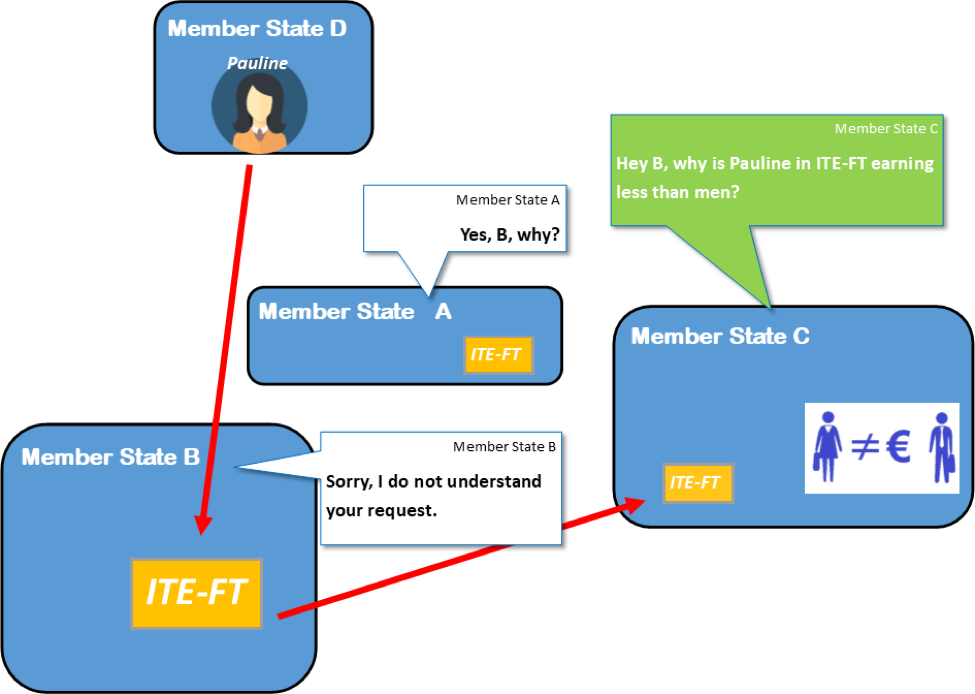By Andrea, Anne-Sophie and Maria
Pauline is a young IT specialist from Member State D and she is moving in with her boyfriend in Member State B, the marvellous country where they met last summer. There, she finds a job at ITE-FT, a company from B with posted-workers in Member States C and A. She is sent to C to develop a technical system for a university in Member State C. Meanwhile, due to reports of unequal payment of men and women by ITE-FT, of which Pauline feels the consequences when she receives her salary, C asks B for information about this company and A follows their example. B refuses to provide this information to both Member States, making it harder for A and C to monitor ITE-FT’s compliance with existing law. However, A’s and C’s powers to investigate and to effectively tackle this problem are territorially limited, making it even harder to ensure compliance with legislation. In light of situations like the fictional one was just described, the European Labour Authority (ELA) was created to tackle such problems.

‘ELA’, what?
The ELA is the newest agency of the European Union and was publicly announced by former President of the European Commission, Jean-Claude Juncker, in his 2017 State of the Union, and after that, it only took two years to set up this agency. The agency started operating at the end of 2019. At the time of writing this blog the Management Board has already had two meetings and the Chairperson and Deputy Chairperson for the Management Board have been elected. The ELA is expected to be fully operational by 2024.

To date approximately 17 million EU citizens are currently working or living in another Member State, additionally there are millions of businesses that operate in a cross-border fashion. These numbers and their cross-border dimension bring complexity to the Internal Market and result in greater difficulties to have a correct application of all EU labour law rules. This can for example be seen in the example mentioned, where it is hard to monitor correct application of the equal pay between men and women outside the territory of the Member State investigating. This agency is aiming to help enforce and inspect EU rules on labour mobility in a fair, simple and effective way. The Authority aims to prevent the abuse of the rights of workers and fraudulent actions from businesses, in order to do so it will provide easier access to relevant and accurate information, increasing the cross-border opportunities for both workers and businesses.
The four freedoms, being the cornerstone of the EU Single Market, have created many benefits for everyone living within the EU, however, they can be at risk of being abused. For example, the freedom of establishment was used as a means to cover up non-compliance with labour law regulations by fraudulent businesses. Currently, as a result of such abusive practices, many problems arise with labour inspections by national authorities, who check whether firms comply with national and Union legislation. Those inspections can be difficult because of tensions between the freedom of services and freedom of establishment, that both differ in the degree in which they safeguard the rules on labour law. More importantly, national labour authorities are constrained to their territory, and therefore, they cannot effectively operate or investigate outside the borders of their state. The ELA can help to overcome the territorial limits by supporting the coordination between Member States, especially with their support in Joint Investigations. These allow multiple Member States to effectively engage in labour inspections and contribute to a reduction of double work, but, more importantly, to the success of the investigation. The ELA has more tasks that can be summarized as facilitating, coordinating, supporting and mediating powers. These powers can be found in Article 4 of Regulation (EU) 2019/1149 and are more elaborated in the subsequent articles. The ELA does not, for now, have powers to act on its own initiative, however, the agency has potential to stimulate the application of rules regarding fair mobility of labour.
What’s in it for me?
From 2024 onwards, the ELA would effectively contribute to making the situation described in the beginning more fair and simple. Starting with Pauline, who has easier access to the job market through EURES Job Mobility Portal, an online platform which helps job seekers to find a job in another Member State. Moreover, she can have easier access to more accurate information regarding her rights in terms of wages, working conditions and mobility schemes. Furthermore, ITE-FT can benefit from easier access to the necessary information on rules and procedures applicable for the recruitment of experts from every corner of Europe, but also on information regarding the laws in A and C, the countries to where it plans to send workers.
Moreover A, B and C can request the ELA to coordinate a joint inspection, where the ELA can provide, for example, translation, logistical and technical support to uncover irregularities within the company of ITE-FT’s company operations. Additionally, C can benefit from a Mutual Assistance project to overcome the unequal payment problem which it has decided to tackle. The program can be initiated so a Member States can receive assistance from experts from other countries that have faced the same challenge, they can share their knowledge on how they tackled these problems. Finally, if the lack of cooperation between C and B regarding the sharing of information results in a conflict the ELA can act as a mediator to reconcile their views.
As seen from the above, the ELA has potential to benefit individuals, companies and Member States. From the fictional situation, one can see only a few examples of where the ELA can be of added value, but the ELA has more tricks up its sleeve. The ELA might gain more powers in the future, but for now, the ELA has great potential to benefit not only Pauline, but millions of EU citizens that are involved in cross-border labour.
